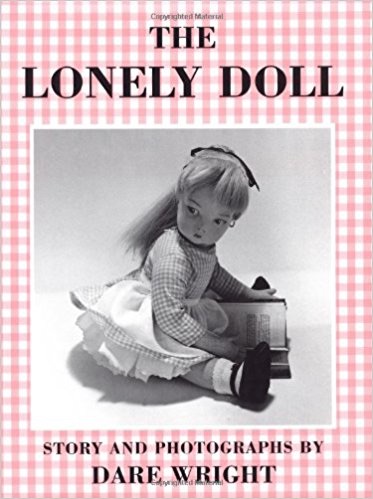The Lonely Doll, Dare Wright
From The Secret Life of Squirrels, we now turn to the secrets of Dare Wright. Her life’s story and life’s work merge into one, because Wright was, herself, a lonely doll. Almost a dozen books (1957-1981) form the The Lonely Doll series. It is in her first that a papa teddy bear adopts the lonely girl, Edith. They, along with his teddy-bear son, become a family, and the subsequent books share their many adventures. The series has, truly, captivating photographs with timeless covers that live in so many's childhood memories. Yet, our views on parenting and gender have changed much since its release, so The Lonely Doll is no longer a children's bedtime staple. The Lonely Doll influenced many of today's successful women from all aspects of the art world. It was an important book from their youth, and some shared their current conflicting feelings about the series with theThe New York Times . They describe Wright's gender stereotypes and parenting approach as uncomfortably out of step with their present beliefs, but it is still part of them. Opinions on gender do’s and don’ts vary and change from generation to generation and from one person to the next. I know my book’s back-cover was once criticized, because my character’s underwear was partially showing. Yet, all I saw were her locks of hair, unexpectedly, swirling in the wind. To me, the way her outfit was captured seemed normal, three-year old behavior, but some might disagree. Edith's short outfits and ruffled underwear, were often positioned bending over things and on display with regularity. When Edith is bad, Wright even has her spanked and in more than one book. Corporal punishment was still the norm in those days, but it makes her work complicated to share with children today even though there is still much to appreciate about it.
The Lonely Doll’s mood can be as grey or as dark as the tones of it’s black-and-white images. Edith’s world is a far cry from a Barbi-glass-half-full one. That is what made it unlike any book in its day and why the images are so memorable to those who grew up with them. In a 2006 Boston Globe interview, Wright’s biographer, Jean Nathan, sums up The Lonely Doll's popularity best :
The Lonely Doll’s mood can be as grey or as dark as the tones of it’s black-and-white images. Edith’s world is a far cry from a Barbi-glass-half-full one. That is what made it unlike any book in its day and why the images are so memorable to those who grew up with them. In a 2006 Boston Globe interview, Wright’s biographer, Jean Nathan, sums up The Lonely Doll's popularity best :
Dare Wright knew exactly what kids care—and worry—about most—misbehaving. Breaking the rules. Wishing their parents wouldn't leave them home, and worrying they wont ever come back.
Wright was a magazine, freelance photographer. Prior to that, she modeled. When Wright decided to use her Rolleiflex to make her first book, she turned to her childhood doll, Edith. The doll went from brunette to blonde and became a young version of Wright's adult self. Unfortunately, Wright’s own model looks never ensured her happiness. Nathan’s,The Secret Life Of The Lonely Doll: The Search For Dare Wright (2004,) painstakingly documents the psychological baggage Wright carried. She suffered parental and sibling separation as a child. Furthermore, her mother, Edie, forced her to live the lie that she had no father or brother, that Edie was a widow and not a divorcée and that Dare was her only child. Her mother was a successful portrait painter of aristocrats and statesmen, which, probably, helped develop Wright’s artistic eye. But the way Edie controlled the rest of her daughter's life stunted her maturation. Wright battled bulimia, anorexia, and later alcoholism. As an adult, Wright showed little qualms about being nude in a photograph or on a beach, but when Wright's relationships reached the point of physical intimacy, she always ran. Though Wright was known to be charming, flirtatious and often courted by men, she’s said to have remained a virgin almost till the end. Late in life, in a tragic turn, she was raped by one of the many Central Park drifters she was known to bring home for drinks and conversation.
The Secret Life well documents Wright’s main strength—her creative vision: she sewed and designed most of her characters’ clothes, styled their hair, applied the makeup, created the sets, photographed and developed her images and wrote the stories. Most was done within in her NYC apartment. Nathan assured me that what little is known about Wright’s photography was included in her book. What is definitely not known is whether Wright's images will continue to endure. Do we toss the doll out with the bathwater and never again open Wright's books? Those who guide children must decide whether to share her work and if so, how best to do that. But adults, one hopes, will continue to indulge in Wright’s art. When put alongside her life's story, the effects of loneliness become apparent to us all.
Hear an interview with Jean Nathan.
Three Lonely Doll books were re-issued in 2004. The rest can be found through second-hand dealers.
Wright was a magazine, freelance photographer. Prior to that, she modeled. When Wright decided to use her Rolleiflex to make her first book, she turned to her childhood doll, Edith. The doll went from brunette to blonde and became a young version of Wright's adult self. Unfortunately, Wright’s own model looks never ensured her happiness. Nathan’s,The Secret Life Of The Lonely Doll: The Search For Dare Wright (2004,) painstakingly documents the psychological baggage Wright carried. She suffered parental and sibling separation as a child. Furthermore, her mother, Edie, forced her to live the lie that she had no father or brother, that Edie was a widow and not a divorcée and that Dare was her only child. Her mother was a successful portrait painter of aristocrats and statesmen, which, probably, helped develop Wright’s artistic eye. But the way Edie controlled the rest of her daughter's life stunted her maturation. Wright battled bulimia, anorexia, and later alcoholism. As an adult, Wright showed little qualms about being nude in a photograph or on a beach, but when Wright's relationships reached the point of physical intimacy, she always ran. Though Wright was known to be charming, flirtatious and often courted by men, she’s said to have remained a virgin almost till the end. Late in life, in a tragic turn, she was raped by one of the many Central Park drifters she was known to bring home for drinks and conversation.
The Secret Life well documents Wright’s main strength—her creative vision: she sewed and designed most of her characters’ clothes, styled their hair, applied the makeup, created the sets, photographed and developed her images and wrote the stories. Most was done within in her NYC apartment. Nathan assured me that what little is known about Wright’s photography was included in her book. What is definitely not known is whether Wright's images will continue to endure. Do we toss the doll out with the bathwater and never again open Wright's books? Those who guide children must decide whether to share her work and if so, how best to do that. But adults, one hopes, will continue to indulge in Wright’s art. When put alongside her life's story, the effects of loneliness become apparent to us all.
Hear an interview with Jean Nathan.
Three Lonely Doll books were re-issued in 2004. The rest can be found through second-hand dealers.



 RSS Feed
RSS Feed